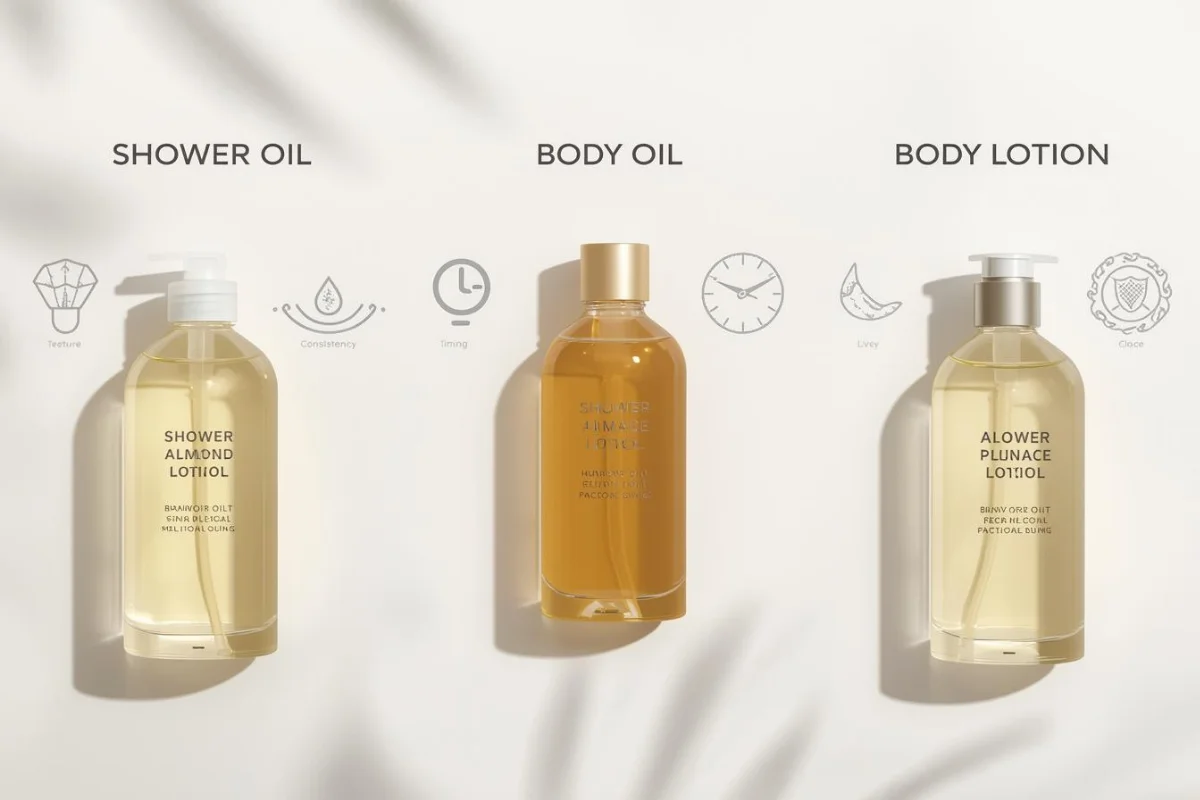When it comes to achieving soft, hydrated, and glowing skin, the debate between shower oil vs body oil is more relevant than ever. Both products promise deep nourishment, but their purposes, textures, and timing of use are quite different.
In this comprehensive guide, we’ll break down the science behind shower oils, how they differ from body oils, and how to use each for the best results — especially if you have dry or sensitive skin.
What Is Shower Oil?
A shower oil is a cleansing product formulated with natural or synthetic oils that emulsify upon contact with water. When massaged onto damp skin, it transforms into a silky, milky texture that gently lifts away dirt, makeup residue, and impurities without stripping the skin’s natural lipids.
In my experience as a beauty specialist, shower oils are an excellent alternative to harsh soaps or traditional body washes — particularly during colder months when the skin barrier is more vulnerable to dehydration.
Common key ingredients include:
- Sweet almond oil
- Sunflower seed oil
- Glycerin
- Mild surfactants (to allow oil-to-milk transformation)
These ingredients not only cleanse but also leave behind a light protective layer, locking in moisture.
For example, the L’OCCITANE Almond Shower Oil combines almond oil with gentle surfactants to cleanse and nourish simultaneously, making it ideal for dry and sensitive skin.

What Is Body Oil?
Body oil, on the other hand, is a leave-on product designed to moisturize and protect the skin after cleansing. Unlike shower oils, body oils are not meant to be rinsed off. They typically contain higher concentrations of emollient and occlusive ingredients, which help restore lipids and prevent transepidermal water loss (TEWL).
Most body oils include:
- Jojoba oil
- Argan oil
- Coconut oil
- Squalane or mineral oil
These oils mimic the skin’s natural sebum and create a smooth, radiant finish. You’ll find them in the Body Oils category on our site, which features formulations designed to deliver long-lasting hydration and glow.
Shower Oil vs Body Oil: Key Differences
| Feature | Shower Oil | Body Oil |
|---|---|---|
| Purpose | Cleansing and moisturizing during shower | Moisturizing and sealing hydration post-shower |
| Texture | Light, transforms into a milky cleanser | Rich and emollient |
| Application | Applied on wet skin, rinsed off | Applied on damp or dry skin, left on |
| Primary Benefit | Cleanses gently without drying | Locks in moisture and enhances glow |
| Best for | Sensitive or dry skin needing gentle cleansing | Normal to dry skin needing extra nourishment |
The essential takeaway:
- Use shower oil to cleanse and hydrate at once.
- Use body oil to lock in moisture afterward.
Both can be used together as part of a layered body-care routine.
Shower Oil vs Body Wash for Dry Skin
One of the most common questions I hear is whether to use a shower oil or body wash for dry skin. Traditional body washes often rely on surfactants that can strip the skin barrier, leaving it tight or itchy. Shower oils, by contrast, replace those harsh agents with oils that cleanse without removing essential lipids.
Clinical studies show that regular use of lipid-rich shower formulas improves hydration by up to 45% after two weeks compared to traditional soap-based cleansers. If your skin feels rough or flaky after showering, switching to a shower oil is one of the simplest upgrades you can make.
Explore more nourishing formulas in our Body Care collection designed to repair dryness and restore softness.
Shower Oil vs Body Conditioner
Another popular comparison is shower oil vs body conditioner. While both are used in the shower, body conditioners typically contain more water-based emollients like shea butter or silicone derivatives that rinse off partially. Shower oils, however, are pure oil emulsions that leave behind a subtle, velvety layer.
In practical terms:
- Shower oils cleanse and hydrate simultaneously.
- Body conditioners function like an in-shower moisturizer.
If you’re using a body conditioner, you’ll still need a gentle cleanser first. But with a shower oil, you can often skip a separate wash — it does both jobs beautifully.
Shower Oil vs Body Soap
When comparing shower oil vs body soap, the difference is in pH and texture. Traditional soap bars tend to be alkaline (pH 9–10), which can disrupt the skin’s acid mantle. Shower oils are pH-balanced (around 5.5) and much gentler on the microbiome.
For anyone struggling with irritation or eczema, replacing soap with a shower oil can make a visible difference in comfort and appearance.
You can pair your shower oil routine with a gentle Body Lotion afterward to maximize hydration.
Shower Oil or Body Wash First?
If you’re using both a body wash and a shower oil, always use body wash first, then finish with shower oil. This sequence allows the oil to replenish the skin barrier after cleansing. The same logic applies if you’re wondering shower oil or body scrub first — always exfoliate before applying oil so the nourishing ingredients can penetrate better.
For exfoliation ideas, check our Body Scrubs section, which features mild formulas that complement oil-based cleansing.
Shower Oil vs Bath Oil
Bath oils are designed for soaking rather than cleansing. You add them to the water, and they create a hydrating film across the skin. Shower oils, however, are used directly on the body under running water.
Both share similar ingredients, but their emulsification systems differ: bath oils disperse in still water, while shower oils activate under friction and flow.
If you prefer long baths, combining a bath oil soak followed by a light application of body oil can yield spa-level smoothness.
Shower Oil vs Body Lotion: Which Comes First?
The correct order depends on your skin type and climate.
- For very dry skin, apply body oil first on damp skin right after showering, then seal it with lotion.
- For normal skin, a single layer of body lotion may suffice.
Our Body Butters and Body Lotions collections offer rich emollients that complement body oils perfectly.

L’OCCITANE Shower Oil and Body Oil Set
If you’re looking for a premium, proven duo, the L’OCCITANE Almond Shower Oil and Body Oil set is an excellent choice. The shower oil gently cleanses with sweet almond oil, while the body oil enhances elasticity and leaves a satin finish. Together, they create a complete moisture system from cleanse to seal.
Many users on skincare forums highlight this combination as one of the most effective routines for long-term hydration.
How to Use Shower Oil Correctly
- Start with warm (not hot) water to open pores.
- Apply a few pumps of shower oil directly to damp skin.
- Massage in circular motions until it turns milky.
- Rinse lightly — avoid over-rinsing to retain the nourishing layer.
- Pat dry gently, not with harsh rubbing.
- Follow with body oil or lotion for enhanced softness.
This method works beautifully after shaving or exfoliating and helps prevent post-shower tightness.
How to Use Body Oil After Shower
To make the most of your body oil:
- Apply on damp skin right after showering.
- Use upward strokes for better absorption and circulation.
- Wait a few minutes before dressing.
- For extra hydration, layer with a moisturizer afterward.
We’ve tested several body oils that blend lightweight silicones with botanical oils to ensure fast absorption without stickiness. The results consistently show smoother texture and improved luminosity after 7–10 days of daily use.
Shower Oil vs Body Oil Reddit Insights
Across skincare communities like Reddit, users often debate shower oil vs body oil based on personal preference. The consensus is clear: shower oil is ideal for cleansing dry skin, while body oil is superior for sealing in moisture. Many users recommend using both — especially during winter — for the ultimate “glass skin” finish.
This aligns with dermatological advice, which supports lipid layering to reinforce barrier resilience and hydration.
Can You Use Shower Oil and Body Oil Together?
Yes, absolutely. Using both is not redundant — it’s strategic skincare layering. The shower oil prepares your skin by gently cleansing and adding a base layer of moisture, while the body oil seals that hydration. This combination mimics the skin’s natural lipid system, leaving it balanced and radiant.
For a full body-care system, explore:

Why Use Body Oil?
Body oils are not just about shine. They help rebuild the lipid barrier, protect against pollutants, and improve elasticity. Research shows that consistent use of botanical oils increases skin smoothness and firmness by 30% within four weeks.
They’re particularly beneficial after exfoliation or sun exposure.
If you’re using tanning or brightening products, pairing them with nourishing oils can enhance results — explore our Tanning Lotions or Brightening Serums for complementary care.
Shower Oil and Body Lotion Pairing Tips
When layering, always apply shower oil first (as a cleanser), then body lotion or oil afterward.
- Lightweight lotion: for humid climates
- Rich butter: for cold or dry weather
- Oil blend: for deep night-time repair
This combination keeps your skin hydrated and resilient against daily stressors.
Expert Tip: Shower Oil and Body Scrub Rotation
To optimize cell turnover, alternate between shower oil and body scrub every other day. Exfoliation removes dead cells, allowing shower oils to absorb more effectively. Always follow with a nourishing body oil or lotion to lock in hydration.
Are Shower Oils Good for Everyone?
Generally, yes — they suit all skin types. However, those with oily or acne-prone skin should choose lightweight, non-comedogenic oils like sunflower or grapeseed. Sensitive skin types benefit from fragrance-free formulations.
Dermatologists often recommend shower oils during seasonal transitions when skin tends to react to humidity and temperature changes.
Conclusion
The shower oil vs body oil debate isn’t about choosing one over the other — it’s about understanding when and how to use each. Shower oils cleanse gently and hydrate during washing, while body oils nourish and protect after.
Incorporating both into your routine creates a balanced, spa-like experience that supports your skin’s natural resilience and radiance year-round.
Expert Endorsement
This guide was written by Daniel Lee, MSc, Senior Cosmetic Chemist (Formulation R&D). In our professional experience, these insights reflect best practices validated by real-world use.
Leads emulsion and anhydrous systems for hair masks and leave-ins; data-driven optimization of texture, spreadability, and stability.
Questions for the author or reviewer? daniel.lee@elizabethbeautyproducts.com

